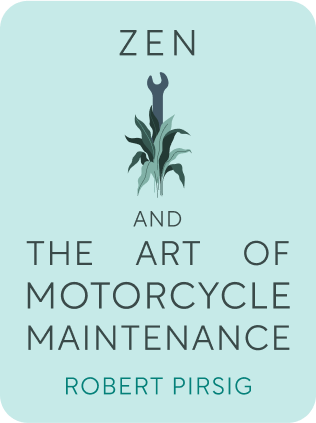

This article is an excerpt from the Shortform book guide to "Zen And The Art Of Motorcycle Maintenance" by Robert Pirsig. Shortform has the world's best summaries and analyses of books you should be reading.
Like this article? Sign up for a free trial here .
What are the two types of thinking? How does Robert Pirsig explain these types of thinking in his book Zen and the Art of Motorcycle Maintenance?
In Zen and the Art of Motorcycle Maintenance, Robert Pirsig explains two types of thinking in the world: classical and romantic. He explains how they’re different, and how to live with both.
Read more about the two types of thinking in Zen and the Art of Motorcycle Maintenance.
Two Types of Thinking
Pirsig rises at 9:00 am; it’s already too hot to sleep. Licking his wounds from the hard ride the day before, Pirsig walks among the surrounding pines lost in thought. He admits that, as he pursued his Chautauquas, he’d hoped he would only have to refer to Phaedrus’s ideas and not the man himself. It’s clear to him now, however, that he cannot avoid talking about Phaedrus personally any longer. He recalls Chris’s American-Indian friend, whose grandmother said ghosts appear only when someone hasn’t been buried correctly. And that’s the problem: Phaedrus wasn’t buried right.
Presently John and Sylvia rise, and the adults begin packing up and cooking breakfast. Pirsig wakes a resistant Chris by yanking his sleeping bag right out from under him. The adults eat their eggs and bacon; Chris takes one bit of food then says his stomach hurts.
Breakfast over, the adults finish breaking down camp. As Pirsig loads the last of his gear onto his cycle’s luggage rack, he notices his rear tire is surprisingly worn down. There’s a problem with the chain as well, and he unpacks his tools to make the necessary adjustment. As John watches Pirsig loosen and tighten the axle, he expresses amazement; he says he wouldn’t even know where to start with an adjustment like the one Pirsig is making. Pirsig, exasperatedly, thinks that that is the whole reason for the Chautauquas, but he tells himself to stay patient—that John is worth teaching. Soon enough the group is on the road again. It’s a picturesque day, and Pirsig has ample time to return to the Chautauquas and discuss the two types of thinking.
Chautauqua: Phaedrus and the Classical/Romantic Dichotomy
Phaedrus, Pirsig finally tells us, was a misunderstood and now-forgotten philosopher. In an ideal world, Phaedrus would stay forgotten, but Pirsig believes he must address Phaedrus head on to exorcise and bury him forever.
Unlike the Sutherlands—and much like Pirsig himself—Phaedrus viewed the world entirely in terms of its underlying form. To properly illustrate the qualities of this particular worldview, Pirsig deploys an admittedly broad but useful dichotomy:
Classical Understanding. A person of classical understanding is rational, scientific, unemotional, cerebral, and technologically savvy. She is more concerned with the underlying form of things than the appearance of things—that is, she cares more about how a thing works than how it looks. Motorcycle maintenance, for example, is classical all the way.
Romantic Understanding. A romantic, oppositely, is intuitive, emotional, creative, and artistically inclined. He is more concerned with immediate appearances than underlying forms—he values aesthetics over utility. Motorcycle riding, for example, is romantic.
Each mode of understanding features in the other. For example, a romantic sees the classical mode of understanding as boring, robotic, overly deliberative—oppressive. A classic, meanwhile, sees the romantic mode as silly, impetuous, irrational—dangerous.
The two modes are, by all appearances, irreconcilable; and Pirsig traces the tumult of the Sixties to the deep antagonism between the classical (“square”) and the romantic (“hip”). These are some of the differencese between the two types of thinking.
Phaedrus’s ideas concerned this perennial divide, but he was ignored, then dismissed, and eventually considered insane. Pirsig opines the insanity was real but caused by people’s opinion of Phaedrus and his ideas rather than an illness. Phaedrus’s end came in the form of an arrest and the permanent removal from society.
The riders stop for gas, and Chris says he’s hungry. Pirsig tells him he either eats with everyone else or not at all. Soon enough they’re back on their cycles. The road they’re traveling is in disrepair and there’s traffic; the sun is bright and the weather sweltering. Pirsig escapes the rough riding by meditating further on the classical world of Phaedrus.Chautauqua: Analytic Description
The classical mode of understanding that Phaedrus subscribed to produces “analytic” descriptions—characterizations and categorizations of things by virtue of their component parts and relationships. For example, take a motorcycle; a motorcycle, at its most basic level, can be divided into two assemblies:
- A running assembly
- A power assembly
The power assembly can be divided further, into:
- The power-delivery system
- The engine
The engine can then be subdivided, into:
- The power train
- The fuel-air system
- The ignition system
- The feedback system
- The lubrication system
And so on, until all components are accounted for within the two types of thinking.
(A “functional” division of the motorcycle is possible as well, beginning with “normal running functions” and “special, operator-controlled functions.”)
There are several qualities to notice about this mode of analysis (beyond the fact that, by Pirsig’s own admission, it’s tremendously dull):
- A description like this is only helpful if you already know how a motorcycle works. In other words, if you’d never seen an assembled motorcycle or watched it move, this description would seem like nonsense.
- There’s no observer involved. That is, the components and operations described are independent of a particular person’s consciousness—they simply exist.
- Value judgments are absent. The description consists in pure facts, without indication whether certain components are “good” or “bad.”
- The description is a product of a particular method of division—an analytic “knife.” Although the division sampled above consists in pure facts, it’s also only one way to analyze a motorcycle. That is, another person, wielding a different analytic “knife,” might cut up and relate the component parts of a motorcycle differently. (Shortform note: Pirsig doesn’t seem to recognize any contradiction between #2 and #4. It would stand to reason that if an analytic description can differ from person to person, then a given description isn’t independent of an observer—rather, it’s the explicit product of a particular observer.)
According to Pirsig, Phaedrus was brilliant with his analytic knife—he was able to break down and systematize the whole world. But it isn’t his immense analytic ability that makes Phaedrus interesting: rather it’s the ambitious and idiosyncratic way he chose to use this skill.
The heat continues to punish the riders. They arrive in a town called Bowman; although the adults are stupefied by the temperature, Chris appears revived and eats two helpings at lunch. Back on the road the heat is nearly unbearable. Pirsig, to cope, resumes his meditation on Phaedrus and the two types of thinking.

———End of Preview———
Like what you just read? Read the rest of the world's best book summary and analysis of Robert Pirsig's "Zen And The Art Of Motorcycle Maintenance" at Shortform .
Here's what you'll find in our full Zen And The Art Of Motorcycle Maintenance summary :
- How an unnamed narrator and his son are on a cross-country motorcycle journey
- Why technology can be creative
- How to focus on what's in front of you in order to get exactly what you need






